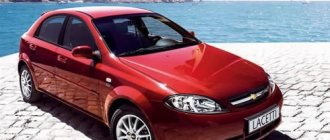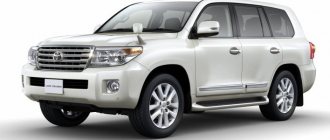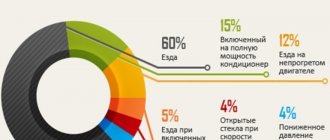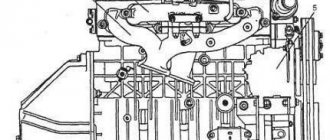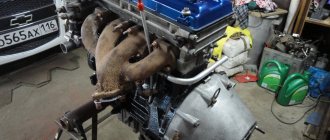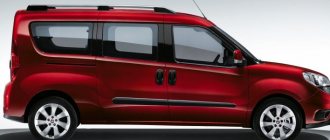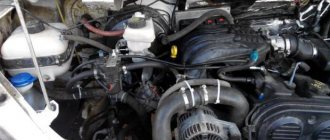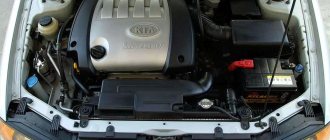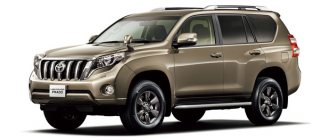GAZ 31105 in detail about fuel consumption
In today's article we will talk about a car that is known to everyone - this is GAZ 31105, also known as Volga. What is the fuel consumption of GAZ 31105 with engine 406 (injector)? What are the pros and cons of operating a car? What are the technical characteristics of this model? Let's figure it out.
What determines fuel consumption?
2.4i (137 hp, 210 Nm, turbo petrol) 5-mech, 2WD
Brief overview of the GAZ model
This Volga model has been produced since 2004 and is the latest modification of the GAZ 3110
. The one hundred and fifth Volga was modernized in 2007 - the appearance was slightly changed, the technical characteristics were improved. And if in matters of appearance, then in terms of improving the technical components everything has been done “excellent”.
As for the engine, there is a good choice here. Initially, the ZMZ 406 injection engine was installed in the Volga. This is 135 horsepower, volume 2.3 liters. For amateurs, it was possible to install a ZMZ 4021 carburetor engine with a volume of two and a half liters. A gas engine is not installed in the Volga - this is an advantage of trucks.
After modification in 2007, American engines began to be used instead of the domestic system. This made it possible to improve the maneuverability of the car, but the average fuel consumption of the GAZ 31105 in the city increased slightly
. Separately, it is worth mentioning the modification of the exhaust system. Its volume was doubled. Due to this, purging in the combustion chambers has improved, and as a result, the toxicity of exhaust gases has decreased.
It's hard to deny the popularity of the fuel injector engine. Both according to the stated parameters and according to reviews from experienced motorists, it is considered more reliable. And gasoline consumption for a GAZ 31105 with a domestic engine is lower than for the same model with another engine of the same volume.
Let's talk a little about appearance. In 2007, the Volga underwent several changes, and now a long trunk and hood have become the norm. New standard 195/65 R15 tires, a smooth ride and a “tenacious” suspension – this is exactly how they speak about this model.
Fuel consumption: standards, statistics and reviews
Regardless of your car model, there are a few general facts you need to know about fuel consumption in general.
.
- The official and real fuel consumption of the GAZ 31105 per 100 km may differ - and this is normal. It is not normal when the difference reaches several liters. In this case, you should contact the service.
- In winter and summer, consumption differs quite significantly. In the case of GAZ 31105, the difference can reach from 1 to 3 liters.
- Fuel consumption 31105 per 100 km on the highway, in the city and off-road can also vary from one to five liters (off-road).
If you calculate your car's fuel consumption yourself, make sure everything is done correctly. Very often, indicators taken at home can be off by up to a liter and a half.
Established fuel consumption standards
The fuel consumption rate of GAZ 31105 on the highway is 12.5 liters
. The actual consumption in summer is about twelve liters, in winter it reaches thirteen. Gasoline consumption for the GAZ 31105 Chrysler is slightly higher by 1-1.5 liters than for the Volga with a ZMZ engine. Fuel consumption in summer is 0.5-1 liter lower. The reason is mainly weather conditions. In winter you have to overcome snowdrifts, i.e. Resistance increases, so more fuel is wasted.
Average consumption in the city for a GAZ 31105 car is 15 liters
for winter and 13 liters for summer. For Chrysler GAZ 31105, you can safely add 2-3 liters to these figures. Off-road consumption standards are 15 liters in summer and 18 liters in winter.
Conclusion: fuel consumption directly depends on the engine power system (diesel, injection, carburetor).
What to do if the consumption is prohibitive
First, try to find the reason for the high fuel costs. Check the ignition system - problems often arise there, which entail an increase in fuel consumption by 1.5-2 times.
Brakes are a completely separate “world” inside the car. The adjustment valve often becomes unusable, and sometimes the brake pads themselves are faulty
, which begin to jam and go back. This not only entails an increase in fuel consumption, but can also result in an accident, because no one knows at what point the brakes will fail.
Check bearings, wheel alignment, check pressure. And, of course, don't forget about the transmission.
If you were unable to find the problem and fix it, we recommend contacting a service station.
GAZ-31105 with ZMZ-405 engine
In 2008, after restyling, the GAZ-31105 received a new ZMZ-40525 injection engine that meets modern Euro-3 requirements. This engine has a volume of 2.5 liters, but thanks to the introduction of an electronically controlled throttle, as well as a modernized cylinder head design, power was increased to 152 hp and torque to 214 Nm.
Fuel consumption of GAZ-31105 with ZMZ-405 engine per 100 km. Reviews
- Nikita, Samara. I received my Volga in 2012 - it was a gift from my wife’s father; after the operation, he could no longer drive, so he decided to give it to us. At first I was not delighted with the gift, but after a month I changed my mind. In fact, the car is not bad - the interior is no worse than in the "ten", and the engine is really powerful and not so voracious - on average 11 liters per 100 km, not much more than that of foreign cars.
- Oleg, Kansk. After purchasing a Volga 31105, 2009, I was really surprised - the car turned out to be quite playful and dynamic. My engine is 405, 150 horsepower - it shoots normally, although it has a ton and a half of total weight. Moreover, it eats 92 gasoline without any problems - I only filled it up, in winter I got up to 13 liters on average, in summer up to 11 liters. The Lada, of course, has less consumption, but the Volga is heavier and larger in size.
- Kirill, Barnaul. What I like about the new Volgas is the chassis. It was strong before, but the new ones are much softer. And the metal of the body is really strong, not like the Prior’s - I somehow got into an accident, almost a head-on collision with the Octavia - my bumper burst and the wing moved, the Octavia’s face was soft-boiled. Consumption is normal for such a car - from 10 to 13 liters, depending on the weather.
- Dmitry, Irkutsk. GAZ-31105, 2.5 l ZMZ-405, 2010. Compared to Ladas, the Volga may not be as playful, but it is much more practical. Its interior is more comfortable, the engine power is enough for such a mass, and the consumption is up to 13 liters in the city and about 9 liters on the highway.
How to achieve optimal fuel consumption for Volga?
- Standard fuel consumption figures
- Factors affecting fuel consumption
The Volga car was equipped with three types of domestically produced engines ZMZ-402, ZMZ-4021 and ZMZ-4062. Since 2006, the plant began to install imported Crysler 2.4L DOHC injection engines. Depending on the configuration, the fuel consumption of the GAZ 31105 was expressed in slightly different figures.
Standard fuel consumption figures
There are many legends about the “gluttony” of GAZ cars, but at the same time they do not exceed the Ministry of Transport standards for fuel consumption in 2013. The parameters specified in the technical documentation do not always correspond to actual operating conditions. Special techniques made it possible to achieve more realistic consumption figures by dividing the vehicle’s movement into cycles: urban, suburban and mixed. Based on this, the average figures show consumption per 100 km:
- in city mode – 13.5 l;
- in suburban mode - 8.8 l;
- in mixed mode - 11 l.
Looking at these indicators, the feasibility of the emergence of “hybrid” cars becomes clear, since the use of an electric motor in urban conditions will save a good portion of fuel. Based on the operating fuel consumption of the Volga-GAZ 31105, it is possible to calculate the cost of a trip over a certain distance based on specific conditions.
Factors affecting fuel consumption
Do some cars equipped with ZMZ engines of previous generations require warming up? especially in the winter season, which reduces the fuel efficiency of the car. The latest power units do not need to be warmed up and can be driven immediately after starting. Naturally, the consumption of such models is minimal. A prerequisite is to keep the car in good technical condition. This primarily includes strict adherence to technological standards for carrying out maintenance and related work:
- replacement of filter elements;
- timing adjustment;
- cleaning or replacing spark plugs;
- washing or replacing injectors;
- timely replacement of the timing chain;
- computer diagnostics of the fuel supply control system.
In addition to the technical side of the issue of saving fuel, there are several other significant factors. Some owners thoughtlessly install so-called “aerodynamic body kits”, all kinds of mudguards, aprons and trunk. Most often, such “tuning” at speeds above 60 km/h increases fuel consumption by 15%, and this is a significant figure. Don't forget about open windows while driving - that's 5% down the drain.
Engine ZMZ 406
- Engines
- ZMZ
- 406
The 2.3-liter ZMZ 406 engine was assembled at the Zavolzhsky Motor Plant from 1996 to 2008 and installed on many Volga sedans, as well as Gazelle commercial minibuses. There are three versions of this engine: carburetor 4061.10, 4063.10 and injection 4062.10.
This series also includes internal combustion engines: 402, 405, 409 and PRO.
- Characteristics
- Consumption
- Application
- Breakdowns
Technical characteristics of the ZMZ-406 2.3 liter engine
Carburetor version of ZMZ 4061
| Exact volume | 2286 cm³ |
| Supply system | carburetor |
| Engine power | 100 hp |
| Torque | 182 Nm |
| Cylinder block | cast iron R4 |
| Block head | aluminum 16v |
| Cylinder diameter | 92 mm |
| Piston stroke | 86 mm |
| Compression ratio | 8.0 |
| Features of internal combustion engines | No |
| Hydraulic compensators | Yes |
| Timing drive | chain |
| Phase regulator | No |
| Turbocharging | No |
| What kind of oil to pour | 6.0 liters 10W-40 |
| Fuel type | AI-76 |
| Environmental class | EURO 0 |
| Approximate resource | 220,000 km |
Injection version of ZMZ 4062
| Exact volume | 2286 cm³ |
| Supply system | injector |
| Engine power | 130 - 150 hp |
| Torque | 185 - 205 Nm |
| Cylinder block | aluminum R4 |
| Block head | aluminum 16v |
| Cylinder diameter | 92 mm |
| Piston stroke | 86 mm |
| Compression ratio | 9.1 — 9.3 |
| Features of internal combustion engines | No |
| Hydraulic compensators | Yes |
| Timing drive | chain |
| Phase regulator | No |
| Turbocharging | No |
| What kind of oil to pour | 6.0 liters 5W-30 |
| Fuel type | AI-92 |
| Environmental class | EURO 2 |
| Approximate resource | 230,000 km |
Carburetor version of ZMZ 4063
| Exact volume | 2286 cm³ |
| Supply system | carburetor |
| Engine power | 110 hp |
| Torque | 191 Nm |
| Cylinder block | aluminum R4 |
| Block head | aluminum 16v |
| Cylinder diameter | 92 mm |
| Piston stroke | 86 mm |
| Compression ratio | 9.3 |
| Features of internal combustion engines | No |
| Hydraulic compensators | Yes |
| Timing drive | chain |
| Phase regulator | No |
| Turbocharging | No |
| What kind of oil to pour | 6.0 liters 10W-40 |
| Fuel type | AI-92 |
| Environmental class | EURO 0 |
| Approximate resource | 240,000 km |
Fuel consumption ZMZ 406
Using the example of a 2005 GAZ 31105 with a manual transmission:
| City | 13.5 liters |
| Route | 8.8 liters |
| Mixed | 11.0 liters |
Similar engines from other manufacturers:
What cars were equipped with the ZMZ 406 engine?
GAS
| 3102 | 1997 — 2008 |
| 3110 | 1997 — 2005 |
| 31105 | 2003 — 2008 |
| Gazelle | 1997 — 2003 |
Disadvantages, breakdowns and problems of ZMZ 406
Most often, owners on the forum complain about capricious carburetor versions
The timing chain has low reliability; it’s good that it doesn’t bend if the valve breaks
The ignition system causes a lot of problems; coils are most often used here
Hydraulic compensators usually last no more than 50,000 km, and then start knocking
Quite quickly, the oil scraper rings become lodged in the engine and oil loss begins.
You can contact the site administrator by email: [email protected]
All texts were written by me, are authored by Google, included in the original Yandex texts and notarized. For any borrowing, we immediately write an official letter on company letterhead in support of search networks, your hosting and domain registrar.
Next we go to court. Don’t try your luck, we have more than thirty successful Internet projects and have already won a dozen lawsuits.
Fuel consumption GAZ 31105 Volga
Rated fuel consumption is one of the most informative and important characteristics of a car for the driver. This is what manufacturers often use to advertise and promote a particular new car model.
Among owners of used cars, it is considered acceptable to consume up to 10 liters of gasoline or diesel per 100 kilometers. In foreign countries, this indicator is indicated in miles, so recalculation into “native” units is often necessary. The fuel consumption tables available in this section of the site are considered very useful.
What does the fuel consumption indicator indicate? What does this characteristic mean? We are talking about hydrocarbon fuel consumption. For example, for an SUV the figure corresponds to 9.5 liters per 100 km. It is quite acceptable, primarily due to the weight and power of the car. The indicator can be reduced due to the following:
lightening the weight of the car when replacing body and chassis elements with innovative materials;
For new models, consumption of 6 l/100 km is considered quite a “cruising” figure, but it will be higher for heavy SUVs and pickups and lower for small hybrids. The necessary information can be found in the tables provided.
What to do if fuel consumption is higher than rated? If the car consumes more fuel and does not correspond to the nominal value indicated in the table, this means there is a malfunction. Experienced service center technicians will tell you how serious it is and how it can be eliminated. In some cases, tuning makes it possible to further optimize fuel consumption, but this is usually achieved by lightening the body structure or by replacing the engine. Professional automotive technicians can provide specific recommendations.
Fuel consumption of the GAZ 31105 Volga ranges from 9.7 to 13.8 liters per 100 km.
GAZ 31105 Volga is produced with the following types of fuel: Diesel fuel, AI-92 gasoline.
"Volga 31105": technical characteristics, reviews and fuel consumption
Cars that are produced in our country rarely become quite popular. So, Americans, if they reach a certain social level in life, sell their old Cadillacs and buy a BMW or Mercedes. Italians never drive Fiats, and those who buy such cars are total losers. In our country everything is completely different. Previously, the Volga was considered something of a cult. People still continue to drive these cars. When the leaders of the Gorky Automobile Plant announced that they intended to curtail production, our car enthusiasts made a fuss, and the plant decided not to stop the conveyors. But first things first. Let's look at the new model from GAZ. This is Volga 31105. You will definitely like her photo.
Communities › GAZ Volga › Blog › Gasoline consumption for engine 406
Today I had to do a run on 31105 (engine 406) about 250 km. with an average speed of 90-100 km/h on a good road in heavy rain and calm driving. Average consumption was approximately 12 l/100 km. Is this normal fuel consumption? Thank you for rating.
Comments 31
8-10 at a speed of 90. and 10-11 at a speed of 140-150. tested on a 1000 km trip. went there 90-100 back loaded 140-150 federal road excellent
It's a lot. I “eat” no more than 10 liters. per hundred
It's easy to check the firmware. If it's sport, there is one, it will skid on dry asphalt from a standstill. With a sharp start. With this firmware, the consumption, as I read in the instructions, is not standardized. When flashing the firmware, the standard found in most Mikas will stall. There is also economy firmware. but it’s generally stupid, although the manufacturer promises consumption within 7 liters. These are gas firmwares. I won’t say anything about the collective farm. anyway, it makes sense to try to check. if at the start there is no sharp TSGI, then we change the filter; if nothing has changed, we look at the DMRV.
Fuel consumption GAZ 31105 (Volga)
The driver is the most dangerous component of the car
The last classic Volga began to be assembled in 2003, and already in 2010 it left the production lines. GAZ 31105 was produced only in a sedan body and only for domestic buyers. Of course, there were very small deliveries to neighboring countries, but they were so small that there is no point in taking them into account.
Official data (l/100 km)
| Engine | Consumption (city) | Consumption (highway) | Flow (mixed) |
| 2.3 MT 131 hp gasoline (manual) | 13.5 | 8.8 | 11.0 |
| 2.4 MT 137 hp gasoline (manual) | 10.8 | 8.7 | 9.5 |
| 2.4 MT 95 hp gasoline (manual) | 13.5 | 8.8 | 11.0 |
The Volga 31105 was equipped modestly. The first of the possible options is the 2.3 engine, developing 131 horsepower. Fuel was supplied to it by an injector, and it was paired with a manual gearbox with five stages. Fuel consumption per 100 km for this version was 11.1 liters.
The second option is 2.4, in which the strength indicator depended on the fuel delivery system. If this work was performed by a carburetor, then there were 95 horses, and if the injector was used, then 137. Both configurations were complemented by a manual transmission. Gasoline consumption here was only 9.8 liters.
Owner reviews
“I drove our ten for a very long time, but something stuck with me, and I thought of buying a Volga. This was probably my stupidest decision in my life. It's a little faster, has more space, but uses fuel like two Ladas. If before I used no more than 8 liters, then here I have never spent less than 16 in the city. Their interiors are the same in terms of comfort, but the Gas is assembled a little better, since nothing creaks or rattles. There have been no breakdowns yet, but even without them, money is spent on maintaining just a carriage,” wrote Nikolai from St. Petersburg.
“I received the Volga from my father. In fact, this is my first personal transport. I drove for a long time without problems, everything was fine. But at some point the consumption simply jumped to astronomical levels. The engine installed here is a 406 injector, everything should seem to be normal, however, 15 liters were wasted instead of 11. This turn of events upset me greatly and I sold the car because there were not enough funds to maintain it. In itself, it was not bad, the interior was more or less comfortable, not to say comfortable, but not the worst. The engine developed a good speed and did it quite quickly,” writes Yuri from Tula.
“I have no complaints about the car for twelve years now. I bought the car from a dealership, so I always tried to maintain it in perfect condition. Of course, the car begins to resist this a little and rot even though I treated the body with various coatings. There have never been any problems with the engine, it works well, but only in warm weather. In winter it is very difficult to start, and consumption increases from 11 to 14 liters,” said Denis from Moscow.
“Sometimes I get the impression that I don’t have a Volga sedan, but some kind of SUV. Several times I found myself in the forest in bad weather and the car always coped well with the difficulties presented. It also handles well on the track, handles and accelerates well. It just consumes a lot of fuel. Even though it is 92 gasoline, it consumes 15 liters, which is simply colossal for such a sedan,” said Roman from Vologda.
“My Volga was bought secondhand, and even with a foreign engine. It has the same power as ours, but it consumes much more fuel. When I chose the car, I didn’t know this. Now I’m struggling with city consumption of up to 18 liters. On the track this figure is a little more moderate - about 12, but it is still a lot, especially since there is not so much strength, and the speed indicators are very far from ideal. I think I should sell it to choose something more economical,” noted Kirill from Voronezh.
“This Volga makes me happy every day more and more. In terms of speed, no other of our models can compare with it, nor in terms of comfort. And the build quality is much better here. I have never once gone to the service center to fix problems, since they simply did not exist. The body suffers a little, but these are minor things. True, there is one indicator in which Gas lags far behind. They are used to making trucks, and this model got the fuel consumption from him. In the summer it is usually 12 liters, but in the winter the engine can easily consume all 15,” responded Alexey from Yaroslavl.
“I have driven many Volgas, but this is the one I remember most. It was after this that I lost faith in our auto industry. Before this, everything was always great, there were no complaints, but in this model everything was done very poorly, the car is always in service. It’s good that the service is cheap, otherwise I would go broke. Although you can spend all the money here without repairs, because the consumption is the same as that of a spaceship. It is considered normal for a model to spend under 20 liters in the city, and with a calm and leisurely ride,” wrote Evgeniy from Vladimir.
“The car became my last Russian one. After it, I began to give preference to foreign cars. It seems to be already the twenty-first century, but the assembly is at the level of the seventies. You can completely forget about comfort here, at least the windows open. The engine is very weak, although the horses are well maintained, they are somewhat sluggish. Acceleration is long, the maximum speed is actually about 130 kilometers per hour. But the amount of fuel consumed is simply unrealistic. Usually 19 liters,” said Valery from Chelyabinsk.
GAZ-31105 with ZMZ-406 engine
The transitional version from the ZMZ-402 carburetor engines is the more modern 2.3 liter ZMZ-406 engine. For GAZ-31105 vehicles, only engines with distributed fuel injection were installed, developing a power of 131 hp. and a torque of 188 Nm. These motors were installed from 2004 to 2008, after which they were replaced by the more powerful ZMZ-40525.
Reviews about the fuel consumption of the GAZ-31105 with the ZMZ-406 engine
- Maxim, Nizhny Novgorod. What captivates me about the Volga is its cross-country ability. The engine power and ground clearance are enough to drive along the most rugged dirt roads. Consumption is of course bad if you drive through mud - 14-16 liters, like from a bush. But if on the highway, then it’s normal - on average 10 liters per 100 km comes out.
- Alexey, Murmansk. Three years ago I sold the VAZ-2110 and bought a GAZ-31105. On the one hand, the interior is much larger - what we needed for the family. But on the other hand, the barge is just kind of clumsy, its dimensions are huge, you can’t park anywhere properly, and its consumption is high - in the city it’s from 13 to 14 liters, 4 liters more than the “ten”.
- Anton, Ust-Kut. The car was bought in 2008, the “rogue” configuration, i.e. completely naked. I was persuaded to buy a used Japanese car, but I decided to buy a new car - I don’t have to worry about repairs, that’s all. There were no particular complaints, except for gas consumption - it eats it up like a cow, 13-14 liters in the city - this is still a normal figure.
- Alexander, Cheboksary. I have been driving my Volga -31105 since 2006 for almost 10 years. If your hands grow where they need to and you take care of the car, there won’t be any problems, guaranteed. The main thing is to remember to add oil to the thresholds at least once every 1-2 months so that they do not rot. Yes, the consumption is higher than that of VAZs - I got 13 liters in the city in the summer and 15 in the winter, about 10 liters on the highway. But keep in mind that the car weighs almost one and a half tons and has a 2.3 liter engine.
- Andrey, Saratov. I will say this - the 406 engine that is installed on the Volga is one of the most successful domestic engines. No whims, no surprises - it starts even at -30 below zero, pulls properly, easily consumes 92 gasoline. You won't get any dynamics from it - but then there are no problems either. In winter, consumption is from 12 to 14 liters - depending on the cold and road conditions; in the summer in the city I have 11.5 liters.
- Nikolay, Tver. In 2010, I bought a five-year-old GAZ-31105 with a ZMZ-406 engine. The quality of the paintwork and assembly sucks, but by the way there are practically no complaints about the engine. The AI-92 always ran without problems (compared to the AI-95 there is no difference at all) - it pulled properly. On the highway the consumption was about 10 liters, in the city from 12 to 14 liters, depending on traffic jams.
- Konstantin, Omsk. For my budget, there was only one choice - the domestic auto industry. But after looking at five TAZs with their wretched and flimsy interior, I still decided to take the Volga. I bought it at a dealership in 2006 - I figured that the new one would last at least a couple of years without any problems. Motor ZMZ-406, I read that it is an analogue of the SAAB engine - the spare parts fit exactly the same. By the way, I have a derated one, 130 horsepower, but it pulls just right. Consumption is within reasonable limits - highway is about 10 liters, city up to 14.5 liters, no more.
- Stanislav, Krasnodar. My father also bought the GAZ-31105 - for him, the Volga is still a legend of the Soviet automobile industry. I had a VAZ-21103, it broke down constantly, after my father gave me his Volga (with a mileage of 60 thousand km), I couldn’t get enough of it - it didn’t break down. In reality, there were no such problems as with the basin at all - only small things, the main thing is not to forget to lubricate the main components, especially the suspension. The iron is good, thick, but if you don’t lubricate the thresholds, they will rust. The engine is also decent - 130 horses, but the volume is 2500 cubic meters, just right for the Volga. In terms of consumption, many write that it eats like a cow. The engine is 2.5 liters - my consumption is from 11 to 14 liters in the city. A lot of? And how much should it be, if the TAZ more than once reached 10 liters in the city, with a 1.5 liter engine.
Engine ZMZ-406
ZMZ-406 is a line of in-line 4-cylinder 16-valve gasoline automobile internal combustion engines produced by Zavolzhsky Motor Plant OJSC. The ZMZ-406 engine was originally designed for installation on the promising GAZ-3105 model. The first engine prototypes appeared in 1993, small-scale assembly began in 1996, and entered the main assembly line in 1997.
The engine was originally designed for modern microprocessor-controlled power and ignition systems; carburetor versions appeared later (injection version - ZMZ-4062.10, carburetor versions - ZMZ-4061.10 and 4063.10). For the first time in the Russian engine industry, the following were used in the design of the ZMZ-406: 4 valves per cylinder, hydraulic pushers, a 2-stage chain drive of 2 camshafts, an electronic fuel injection and ignition control system.
Specifications
* - for engine ZMZ 4061.10 ** - for engine ZMZ 4063.10
Modifications of internal combustion engine 3M3-406
- 3M3-4062.10 – injection engine for AI-92 gasoline. It has a compression ratio of 9.3. Power – 150 hp For cars and minibuses GAZ 31054 Luxe configuration; GAZ 3102 (1996 – 2008).
- 3M3-40621.10 is a modification of the 3M3-4062.10 engine that meets the Euro-2 environmental standard.
- 3M3-4063.10 is a carburetor version of the engine, designed for installation on light commercial trucks and minibuses GAZ 3302, 33023, 2705, 3221, 32213, 322132, 32214, SemAR 3234, Ruta, Bogdan and Dolphin. The compression ratio was reduced to 8 for A-76 gasoline. Power – 110 hp
- 3M3-4061.10 – carburetor engine for light commercial vehicles GAZ 3302, 33023, 2705, 3221. The compression ratio is reduced to 8 for A-76 gasoline. Power - 100 hp
Common faults and operation
- Most often, owners complain about capricious carburetor versions;
- The timing chain has low reliability (it does not bend if the valve breaks);
- The ignition system causes many problems, most often the coils;
- Hydraulic compensators usually last no more than 50,000 km, and then start knocking;
- The oil scraper rings quickly become stuck and the oil burn begins.
The carburetor 406 engine is less economical due to the impossibility of accurately adjusting the gasoline supply. It is almost impossible to more accurately regulate the amount of fuel, which affects power and fuel consumption.
The injector is noticeably superior to its carburetor counterpart in terms of reliability, efficiency and power. One of the main positive qualities of injectors is the absence of the need to make mandatory engine adjustments. The power supply system here is not subject to clogging, there are no jets, and the exact amount of fuel flows directly into the cylinders.
Engines models ZMZ-4061.10 and 4063.10 (left view): 1 - drain plug; 2 - oil sump; 3 — exhaust manifold; 4 — engine support bracket; 5 — coolant drain valve; 6 - water pump; 7 — emergency coolant temperature sensor; 8 — coolant temperature indicator sensor; 9 — engine temperature sensor; 10 — thermostat housing; 11 — emergency oil pressure sensor; 12 — oil pressure indicator sensor; 13 — oil level indicator (dipstick); 14 - ignition coil.
Engines model ZMZ-4061.10 and 4063.10 (right view): 1 - synchronization disk; 2 — synchronization sensor; 3 - oil filter; 4 - starter; 5 — knock sensor; 6 — pipe for draining coolant from the heater; 7 — inlet pipe; 8 — hydraulic chain tensioner; 9 - generator; 10 — generator belt; 11 — water pump pulley; 12 — tension roller; 13 - fuel pump.
Cross section of ZMZ-4061.10 and 4063.10: 1 - oil sump; 2 — oil pump receiver; 3 - oil pump; 4 — oil pump drive; 5 — intermediate shaft gear; 6 — cylinder block; 7 — inlet pipe; 8 — ventilation pipes; 9 — intake camshaft; 10 — inlet valve; 11 — valve cover; 12 — exhaust camshaft; 13 — oil level indicator (dipstick); 14 — hydraulic valve pusher; 15 — outer valve spring; 16 — valve guide; 17 — exhaust valve; 18 — cylinder head; 19 — exhaust manifold; 20 - piston; 21 — piston pin; 22 — connecting rod; 23 - crankshaft; 24 — connecting rod cover; 25 — main bearing cover; 26 — drain plug; 27 — pusher body; 28 — guide sleeve; 29 — compensator body; 30 — retaining ring; 31 — compensator piston; 32 - ball valve; 33 — ball valve spring; 34 — ball valve body; 35 — expansion spring.
Gazelle 406
Gazelle 406 2.2 – fuel consumption per 100 km
- City cycle: 14.5 l
- Extra-urban cycle: 10.1 l
- Mixed cycle: 13.5 l
Gazelle 406 (carburetor) – fuel consumption per 100 km
- City cycle: 15.0 l
- Extra-urban cycle: 12.8 l
- Combined cycle: 14.0 l
Gazelle 406 (injector) – fuel consumption per 100 km
- City cycle: 13.0 l
- Extra-urban cycle: 12.0 l
- Mixed cycle: 11.0 l
A huge number of freight transports are carried out using Gazelles, which are manufactured at the Gorky Automobile Plant. The 406 engine is presented in three modifications - two carburetor and injection, including. It should be noted that the latest engine can be installed not only on minibuses, but even on passenger cars.
As for the advantages of this engine, its amazing efficiency comes to the fore, given its fairly high power. If handled correctly, the engine will be reliable and last a long time. The only thing is that it is harmful in terms of the quality of oil and spark plugs. Frequent overheating of the engine is also possible because the cooling system does not work correctly, and the fan may fail altogether.
Well, you can never do without disadvantages and this engine is no exception. In general, this unit is quite reliable among its competitors and is in demand and respect among car enthusiasts. You don’t have to worry about spare parts either, since stores have a wide range of parts for this engine. Considering the exorbitant prices for repairing engines from foreign manufacturers, the 406 model is quite inexpensive to maintain, which is very good.
The volume of both carburetor and injection engines is about 2.5 liters. But, what is very important, the first carburetor engine should be filled with 76 gasoline, the injection engine with 92 gasoline, and the second carburetor also with 92 gasoline. Power varies from 100 to 145 horsepower, depending on the modification.
Table of fuel costs for Chrysler brands.
The table describes the average costs for different Chrysler brands. Fuel consumption is presented in three types - city, highway and mixed (average) fuel consumption. All fuel consumption data is from the Chrysler car manufacturer. For almost all Chrysler brands, fuel consumption does not exceed 16 liters per 100 km.
| Chrysler brand | Chrysler power, kW | Average fuel consumption Chrysler (l/100 km) | City | Route |
| Chrysler Pa cifica (3.8 L, 6 cylinders, 4-speed automatic transmission) model 2008 | 14.4 | 15.7 | 13 | |
| Pa cifica (4.0 L, 6 cylinders, 6-speed automatic transmission) model 2007 | 15.3 | 16.8 | 13.8 | |
| Chrysler 300 C 2.7 | 142 | 11.3 | ||
| 300 C 3.5 | 183 | 11.8 | ||
| Chrysler 300 C Touring 5.7 | 250 | 16.1 | ||
| 300 M 3.5 | 187 | 13.3 | ||
| Chrysler Cirrus 2.5 | 125 | 10.6 | ||
| Concorde 3.5 | 186 | 11.9 | ||
| Grand Caravan S E3.3 | 116 | 12.4 | ||
| Grand Voyager2.8 CRD | 110 | 9.3 | ||
| Chrysler Grand Voyager 3.3 | 132 | 14.5 (Gas) | ||
| Grand Voyager L E2.5-T | 85 | 10.9 | ||
| Chrysler Grand Voyager L E3.8 | 122 | 14.0 | ||
| LHS 3.5 | 189 | 12.8 | ||
| Neon 2.0 | 98 | 8.6 | ||
| PT Cruiser 2.0 | 104 | 8.3 | ||
| Saratoga 3.0 | 104 | 12.4 | ||
| ChryslerS ebring 2.4 | 125 | 10.2 | ||
| ChryslerS ebring L-X2.7 | 150 | 11.3 | ||
| Chrysler Stratus 2.5 | 120 | 10.5 | ||
| ChryslerTown Country 3.8 (all-wheel drive) | 134 | 15.3 | ||
| Chrysler Vision 3.5 | 155 | 13.1 |
Acceptable fuel consumption from Chrysler!
The car is given good dynamics and acceptable fuel consumption of Chrysler thanks to its reliable engine.
Chrysler has an excellent safety system, and its design creates the image of a stylish and well-coordinated car. Older Chrysler brands are acceptable to most people.
The driver can enjoy all the conditions created for a pleasant and easy ride, thanks to the ergonomic and comfortable interior. The new Chrysler engine demonstrates extreme efficiency, thanks to which the car has low fuel consumption and very low levels of harmful emissions into the atmosphere.
Chrysler - stable quality, excellent design solutions, originality and the latest technology.
More about fuel consumption.
Costs of other cars
Chevrolet fuel consumption
Mazda fuel consumption
Opel fuel consumption
Toyota fuel consumption
